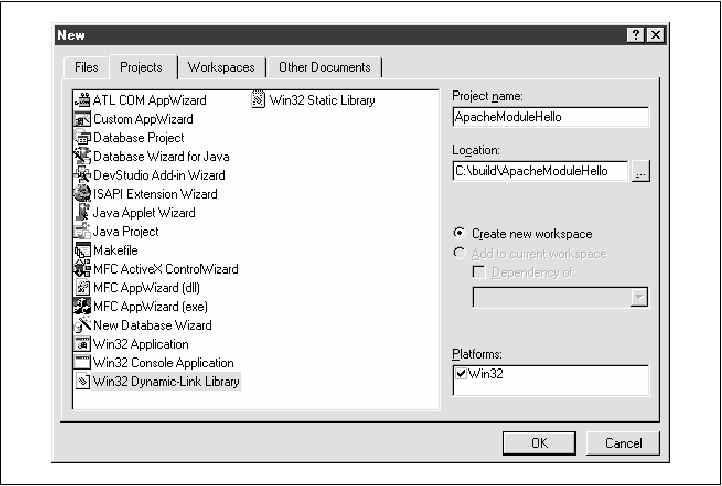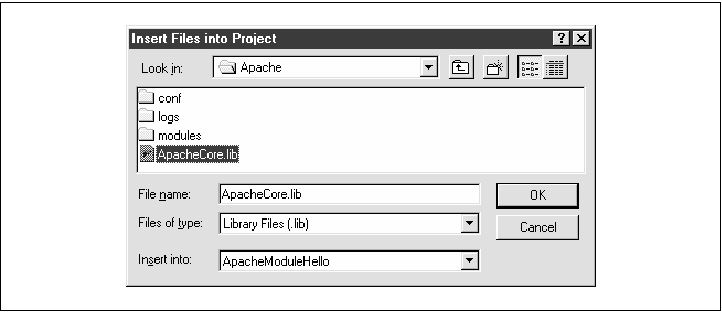|
Show Contents Previous Page Next Page
Chapter 2 - A First Module / "Hello World" with the C API
Building a Dynamically Loadable Module
It can be a pain to relink and reinstall the server executable every time
you make a change to a custom module. As of Version 1.3, Apache offers a way
to build dynamically loadable modules. You build the module as a shared object,
place it somewhere handy, add a LoadModule directive to httpd.conf,
and send the server a restart signal. After the module is loaded, it's indistinguishable
from any other module.
Dynamic loading is available on most systems, including Linux, FreeBSD, Solaris,
BSDI, AIX, and IRIX systems. To configure your server for dynamic loading, recompile
it with the mod_so module installed. mod_so is a standard
Apache module, found in src/modules/standard, but it is not compiled
in by default. From within the Apache source tree, rerun the configure
script, adding mod_so to the list of modules you wish to enable:
% ./configure --enable-module=so --enable-module=other_module ...
Now you must run a full make to rebuild the httpd.
This is only for the purpose of installing the statically linked mod_so.
You won't need to rebuild httpd to add new dynamically loadable
modules. You can install and launch the new httpd now if you wish,
or wait until the dynamically loadable hello_module is ready to
go.
You now have an httpd with mod_so installed, but
you still need to build mod_hello.so. This can be done in one of
two ways. One way is to use the configure script to build a new
dynamically loadable module. From the top of the Apache distribution (where
the ABOUT_APACHE file is located) run the configure
command again, replacing the --enable-module option with --enable-shared:
% ./configure --activate-module=src/modules/site/mod_hello.c \
--enable-shared=hello
When the --enable-shared argument is present, this implies that
mod_so should be built with the server, so there's no need to use
--enable-module=so.
Now you'll need to run make to create the file src/modules/site/mod_hello.so.
When this is done, just copy the shared object file to Apache's libexec
directory:
% cp src/modules/site/mod_hello.so ~www/libexec/
Open httpd.conf and add the following line:
LoadModule hello_module libexec/mod_hello.so
The LoadModule directive, available only when so_module
is installed, takes two arguments. The first is the name of the module to load
at runtime, and the second is the path to the shared object file to load. You
can use a path relative to the server root, as shown here, or an absolute file
path.
A second, and possibly easier way to build a module as a DSO is to use the
apxs program, the "APache eXtenSion" tool. With a single command,
our mod_hello module can be compiled, installed, and configured.
The -c option specifies which module to compile. The -i
option tells apxs to install the module and the -a
option adds the LoadModule directive to your httpd.conf
file.
% ~www/bin/apxs -c -i -a mod_hello.c gcc -DLINUX=2 -DHAS_BOOL -DUSE_HSREGEX -I/usr/local/apache/include -c mod_hello.c -o mod_hello.so mod_hello.o cp mod_hello.so /usr/local/apache/libexec/mod_hello.so chmod 644 /usr/local/apache/libexec/mod_hello.so [activating module 'hello' in /usr/local/apache/conf/httpd.conf]
The main advantage of apxs is that you do not need to store your
C language module source files underneath the Apache source tree but can keep
them anywhere you wish. apxs has numerous other options, the handiest
of which are the -g and -n options, which together
create a dummy "template" directory that you can use as a skeleton on which
to build your own modules. The full details can be found in the apxs
manual page, located in the man subdirectory under the server root.
Regardless of whether you built mod_hello using configure
or apxs, you should now start or restart httpd and
watch the error log for messages. Provided that LogLevel is set to
debug (see Chapter 4, Content
Handlers), you should see a message to this effect:
[Tue Mar 24 07:49:56 1998] [debug] mod_so.c(234): loaded module hello_module
You should now be able to fetch http://your.site/hey/there, and see the familiar page produced by this example script.
Show Contents Go to Top Previous Page Next PageIf your C module consists of more than a single source file, or if it requires linking with shared libraries, see Appendix C, Building Multifile C API Modules.
Building C Modules in the Windows Environment
Show Contents Go to Top Previous Page Next Page As of this writing, Apache does not provide any special support tools for
building third-party modules in the Win32 environment. We'll show you how to
build an Apache module DLL (Dynamic Link Library) using Microsoft Visual C++.
The naming convention for module source files is the same in Win32 systems as
it is in Unix, but the DLL library names generally replace the mod_
prefix with ApacheModule. In our example, we will build an ApacheModuleHello.dll
from our mod_hello.c source file. The source file doesn't have
to be changed in the slightest to compile under Win32.
To ensure that this procedure works, you'll have to compile everything on a Windows NT system (Windows 95/98 doesn't work, although you can run the resulting binaries on 95/98). You may also have to build Apache and Perl from source. The binary distributions are not guaranteed to interoperate correctly with modules you build yourself.
Here is the blow-by-blow procedure:
- Create a new project.
Select the File New menu to bring up the Projects window. Select "Win32 Dynamic-Link
Library" and enter "ApacheModuleHello" as the project name and C:\build\ApacheModuleHello
(or the build location of your choice) as its location. See Figure 2-2.
Figure 2-2. Select "Win32 Dynamic-Link Library" to create a new Apache module project.

- Add the module source files.
From the Project menu, select Add To Project Files. Add mod_hello.c
to the list (Figure 2-3).
Figure 2-3. Add the module source files to the Visual C++ project.

- Add Apache Runtime Library.
Repeat the previous step, adding the Apache core library, C:\Apache\ApacheCore.lib
(Figure 2-4).
Figure 2-4. Add the Apache runtime library
to the build. 
- Add the include directory for Apache header files.
From the Tools Options menu, select Directories. In the dialog box, choose
Include files and add the path to the Apache include directory. This is located
underneath the Apache source tree, in the directory src\include
(Figure 2-5).
Figure 2-5. The Apache include path must be
added to the project directories. 
- Change the Active Configuration setting from Debug to Release.
From the Build Set Active Configuration menu, select Win32 Release. This will enable o ptimizations and turn off debugging code (Figure 2-6).
Figure2-6. Set the Active Configuration. 
- Compile.
From the Build menu, select Build ApacheModuleHello.dll. The compiler will fire up and, if all goes well, create the DLL library. If you get any error messages during this process, go back and fix the problems.
- Install the DLL.
Copy ApacheModuleHello/Release/ApacheModuleHello.dll to the C:\Apache\modules
directory.
- Configure
httpd.
Add the following lines to httpd.conf:
LoadModule hello_module modules/ApacheModuleHello.dll
<Location /hi/there>
SetHandler hello-handler
</Location>
Fire up your favorite browser and request the URI http://your.site/hi/there.
With luck, ApacheModuleHello will run and you'll see the page from
Figure 2-1.
Footnotes
7 Note that if HostNameLookups is configured to be Off, the ap_get_remote_host() function will return the IP address of the client. See Chapter 8, Customizing the Apache Configuration Process, and Chapter 9, Perl API Reference Guide, for more details on the ap_get_remote_host() function.
Show Contents Go to Top Previous Page Next PageCopyright © 1999 by O'Reilly & Associates, Inc.


